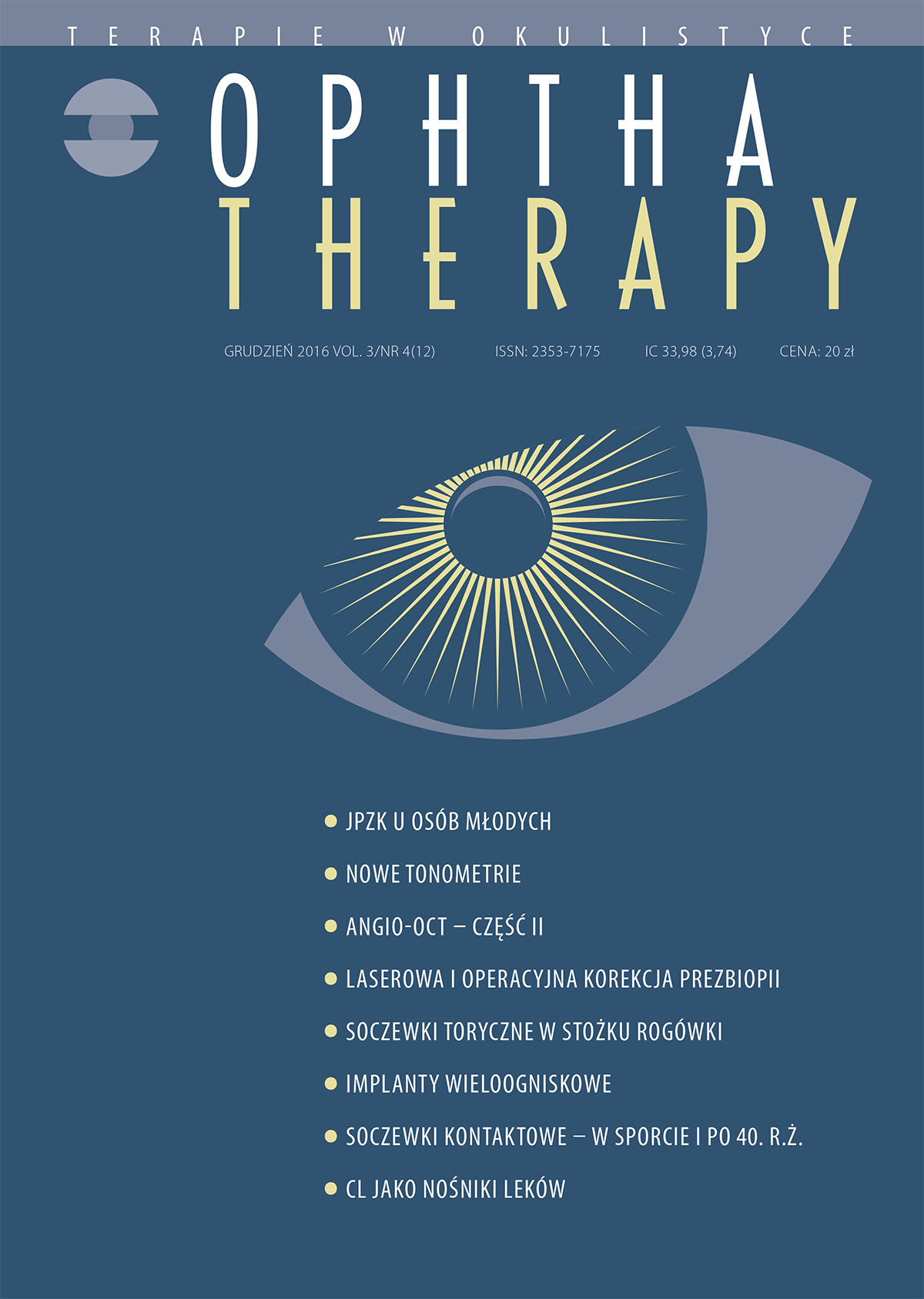Contact lenses as ophthalmic drug carriers
Main Article Content
Abstract
Contact lenses as drug carriers are an alternative for eye drops. Soaking lenses in drug solutions is ineffective, though, with most of the drug released form the lens within a few hours. There is a number of methods in use that increase the drug carrying capacity of contact lenses and prolong the drug’s release over time, including molecular imprinting, vitamin E diffusion barrier, co-polymerization with functional monomers, encapsulating nanoparticles in contact lenses, and generating drug nanodomains within the polymer matrix.
Downloads
Article Details

This work is licensed under a Creative Commons Attribution-NonCommercial-NoDerivatives 4.0 International License.
Copyright: © Medical Education sp. z o.o. License allowing third parties to copy and redistribute the material in any medium or format and to remix, transform, and build upon the material, provided the original work is properly cited and states its license.
Address reprint requests to: Medical Education, Marcin Kuźma (marcin.kuzma@mededu.pl)
References
2. Filipe HP, Henriques J, Reis P et al. Contact lenses as drug controlled release systems: narrative review. Revista Brasileira de Oftalmologia. 2016; 75(3): 241-7.
3. Guzman-Aranguez A, Colligris B, Pintor J. Contact Lenses: Promising Devices for Ocular Drug Delivery. J. Ocul. Pharmacol. Ther. 2013; 29: 189-99.
4. Hu X, Hao L, Wang H et al. Hydrogel Contact Lens for Extended Delivery of Ophthalmic Drugs. Int J Polym Sci. 2011; ID: 814163. https://doi.org/10.1155/2011/814163 .
5. Peng C, Burke MT, Carbia BE et al. Extended drug delivery by contact lenses for glaucoma therapy. J Control. Release. 2012; 162: 152-8.
6. Maulvi FA, Mangukiya MA, Patel PA et al. Extended release of ketotifen from silica shell nanoparticle-laden hydrogel contact lenses: in vitro and in vivo evaluation. J Mater Sci. 2016; 27: 113.
7. Kapoor Y, Thomas JC, Tan G et al. Surfactant-laden soft contact lenses for extended delivery of ophthalmic drugs. Biomaterials. 2009; 30: 867-78.
8. Changhai LU, Roshan B, Kociolek M et al. Hydrogel Containing Silica Shell Cross-Linked Micelles for Ocular Drug Delivery. J. Pharm. Sci. 2013; 105(2): 627-37.
9. Paradiso P, Serro AP, Saramago B et al. Controlled Release of Antibiotics From Vitamin E-Loaded Silicone-Hydrogel Contact Lenses. J. Pharm. Sci. 2016; 105(3): 1164-72.
10. Xu J, Li X, Sun F. In vitro and in vivo evaluation of ketotifen fumarate-loaded silicone hydrogel contact lenses for ocular drug delivery. Drug Deliv. 2011; 18(2): 150-8.
11. Peng C, Chauhan A. Extended cyclosporine delivery by silicone-hydrogel contact lenses. J Control. Release. 2011; 154: 267-74.
12. dos Santos JF, Alvarez-Lorenzo C, Silva M et al. Soft contact lenses functionalized with pendant cyclodextrins for controlled drug delivery. Biomaterials. 2016; 30(7): 1348-55.
13. Luliński P. Polimery ze śladem molekularnym w naukach farmaceutycznych. Polimery. 2010; 11-12: 797-805.
14. Tashakori-Sabzevar F, Mohajeri SA. Development of ocular drug delivery systems using molecularly imprinted soft contact lenses. Drug Dev. Ind. Pharm. 2015; 41(5): 703-13.
15. Yañez F, Martikainen L, Braga MEM et al. Supercritical fluid-assisted preparation of imprinted contact lenses for drug delivery. Acta Biomaterialia. 2011; 7: 1019-30.

